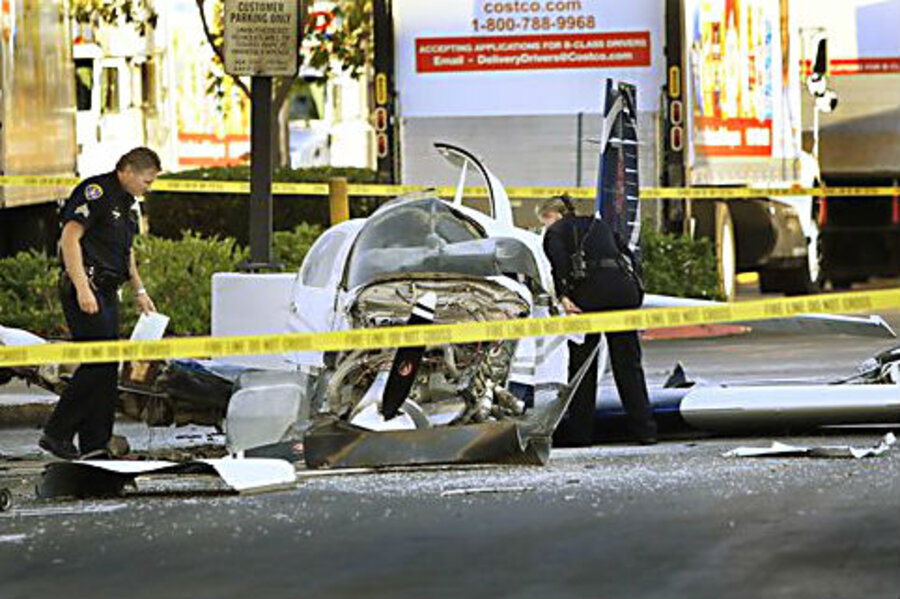San Diego parking lot plane crash: Bystanders rescue pilot, passenger
Loading...
| San Diego
A small plane clipped the top of a store before it crashed in the parking lot of a San Diego shopping center, killing an 80-year-old passenger and seriously injuring the 52-year-old pilot, authorities said.
Several witnesses rushed to douse the plane's flames and pull out the two women, the only people aboard. A man who helped was treated for minor cuts and burns, but no one on the ground was hurt in the crash.
The single-engine 1988 Mooney M-20L went down Wednesday in a parking lot that serves a Costco and a Target store in the Kearny Mesa neighborhood.
The plane bounced while landing at nearby Montgomery Field, continued westbound and went down, said Ian Gregor, a spokesman for the Federal Aviation Administration.
However, helicopter pilot Vince Carter said he had taken off from the field when he heard the pilot tell the control tower in a radio transmission that she had lost power on takeoff.
"She said she lost power and she was going down and that was it," he told KFMB-TV.
It wasn't immediately clear which version of events was correct.
The plane clipped the top of the Target store and knocked down a light pole, police Lt. Steve Behrendt said.
It spun around and finally landed in the parking lot in a loading dock area away from the main entrances, and no cars were there, city fire spokesman Lee Swanson said.
The plane caught fire, but the flames were quickly doused. The passenger had serious burns and died at a hospital, he said.
The pilot also had major injuries, he said. However, Behrendt said, she was expected to survive.
Gregg Smith was working in a nearby office building and saw the plane in trouble. It nearly hit his building, he said.
"I knew they didn't have enough power to do the things they needed to do," he told KNSD-TV. "I knew it was going down."
Smith said the plane left his view, but he then heard a loud thud and then the crash.
"The next thing I saw was a bunch of black smoke," he said.
Smith said he ran outside as he called 911.
He said 15 to 20 people were standing around the plane, some with fire extinguishers, and they extinguished the fire before it reached the plane's fuel tank, and they pulled the women out.
The white plane appeared to be mostly intact, but its nose and one wing were torn up.
"The front of the passenger compartment, the engine is essentially broken off," Swanson said. "The landing gear is off; it's lying flat on its belly. There's some debris for several yards in each direction."
Helicopter pilot Vince Carter, who was in the air and heard the pilot's last radio transmissions saying she was going down, said the pilot may have helped save lives.
"This is a miracle and testament to her skill as a pilot," he told KNSD-TV. "This could have very easily killed a lot of people. You could imagine, just shopping at Target, and a plane comes through the roof full of fuel."
"She stalled it out pretty much perfectly in the only spot she possibly could have," he said.
“From a pilot’s perspective, this is a miracle, an absolute miracle,” Carter told U-T San Diego. “It’s an amazing testament to her skill.”
Speculation about the cause of the crash could be found in the comments on UT San Diego.
The Mooney M20L is a 1980's model, with a Porche engine. The stall speed is around 65 mph, so she had to be faster than that to fly out of ground effect. That aircraft is slippery and hard to slow down, so assuming she flew it controlled to crash, she was probably around 70 mph at impact, wrote Simon Mouer, a retired engineer.
Engine failures are rather rare. More likely there was fuel mismanagement, or water in the fuel tank. That type aircraft (low wing) has a fuel selector that is either left or right wing. Fuel mismanagement is all too common on low wing aircraft because low-time pilots forget about changing the fuel selector (there is usually fuel in the other wing.)
Ken Platt, who identifies himself as working at the US Department of Navy, observes:
The plane may have attempted a landing and bounced on touchdown in which case you would execute a go around. When going around at MYF the procedure is to climb straight out to 500ft AGL and then make a crosswind (left) turn then downwind. 500ft AGL usually is reached right about where Target is (about 20 degrees to the left of the runway) so the turn would have started there. If the plane is going to slow on climb out and started the turn south, it could have stalled and at that altitude there isn't enough time to recover. However, I noticed from the video of the plane, the propeller blades weren't bent which usually means that it wasn't spinning when it crashed which could mean the engine quit.
Either way it is a very sad story for those of us in the local aviation community.
The National Transportation Safety Board is conducting an investigation into the cause of the crash.
Copyright 2014 The Associated Press. All rights reserved. This material may not be published, broadcast, rewritten or redistributed.







